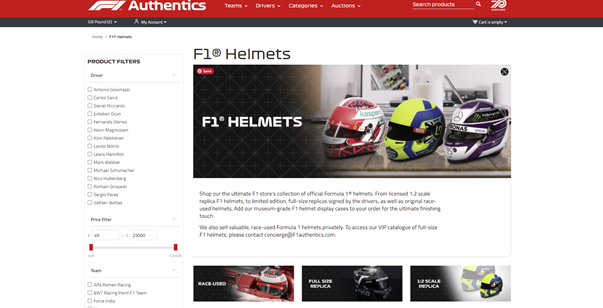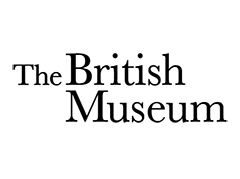You may have heard the term and are now asking yourself, what is faceted search? Faceted navigation and search are the same things; it is a feature on a website that allows the user to filter products shown based on a range of different attributes.
We are sure you have seen it before. Large eCommerce sites use faceted search, for example, our client F1 Authentics. Faceted navigation creates a better user experience by letting the user filter down to their particular interest rather than sift through countless products they are not interested in.
Faceted Search or Faceted Navigation? Both technically correct, faceted search– it is a way to search for products with specific features. Faceted navigation- also makes sense as it is a way to navigate through your results.
We’ll let you decide what you want to call it. :)
Faced Navigation Examples
Let’s take our client F1 Authentics for example. This work is still ongoing, but the foundations are there. F1 Authentics sells a range of memorabilia from teams and drives of Formula One.
Let’s take their bestselling category, Helmets, considering the audience – F1 fans. If you are an F1 fan, you could be a fan of a team or a specific driver. So some may be searching for driver-specific memorabilia and others may search team-specific memorabilia. We also have to consider F1 Authentics sells different helmets: race-used, full-size replicas, and scale replicas.
So while ‘helmets’ is the main category, faceted search allows users to search for precisely what they want – not having to sift through all the products.
For F1 Authentics, you can search by team, driver, price, and category.

Consider huge eCommerce stores like Wayfair and Loaf, if you are looking for a four-seater orange corner sofa, imagine having to sift through the thousands of sofas to find what you are looking for. Thanks to faceted search you can filter by colour, size, and shape to look through options specific to your interest.
Why is Faceted Search important for site navigation?
Faceted search is an essential component of optimised search because it promotes a fast and intuitive exploration process. By eliminating the need to scroll through a ridiculous amount of results, we improve users’ experience when on the site, resulting in more engaged users and higher conversion rates.
Additional ways faceted search promotes an efficient and intuitive user experience:
- Reduces the need for multiple searches – Unlike typing in a search bar, with faceted search if a customer does not immediately find an item that matches their specifications they do not have to keep changing and experimenting with their search queries. They can simply select and apply the correct facets to get closer to their needs.
- Efficiently shows available items – Facets can bring the users attention to brands, styles, sizes, and other attributes they may have missed.
- Makes an extensive content catalogue more manageable – Faceted search allows users to navigate through much more content, opening up the door to sell more items.
Faceted Navigation Best Practices
Consider the Customer
Take it back to the heart of all marketing – the customer. You will want to understand what and how they are searching for your products. Looking at popular long-tailed keywords are essential here ‘red women’s top’ ‘red long-sleeved women’s top’. For these, facets to consider would be gender, clothing type (top, bottoms, etc.) and style (short sleeve, long sleeve). You’ll want to do keyword research and look at search analytics to get started.
Use the right number of facets
Be careful because there is such a thing as too many options! The number of facets you make available on your site should be logical and make sense with the user’s intent. Avoid overwhelming the customer by avoiding large numbers of facets, especially when they are unnecessary or unused.
There may be facets that aren’t used; you can monitor these and get rid of them ongoing.
Allow multiple facets to be selected at once
Allowing multiple facets to be selected improves users’ experience as they are likely to find what they want faster and easier.
Use thematic filters
An example of a thematic filter would be Asos’s ‘Going Out’ or ‘Formal’ facet clothing options. These facets are more general and subjective, however, they work because they capture moods and tastes that a more passive browser may be looking for in the exploration process.
Show the number of results that match the facets selected
This is one more feature that helps improve the user’s experience when searching your site. Showing the number of results a facet will show them how efficient their search queries were.
A good, faceted search and navigation experience requires careful planning and integration. You’ll need to set up and monitor a well-designed system for faceting and filtering content. At ExtraDigital , our marketing and development teams work closely together, enabling us to create faceting strategies that consider the site architecture and are optimised for conversions.
Have you outgrown your eCommerce store?
Find out if you’re on the right platform with our quiz.
We’re always available for a free consultation, get in touch with us at +44 (0)1227 68 68 98 if you would like to hear our innovative ideas!











